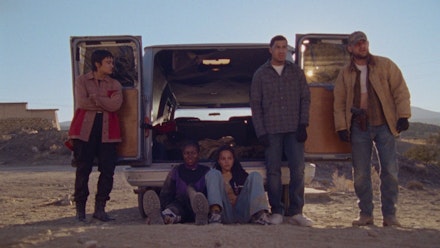“This is an act of self-defence,” clarify the protagonists of How To Blow Up A Pipeline. It’s a film which highlights that climate disaster isn’t a passive problem — it’s a doom we’re actively being ferried towards, it argues, through ruthless, unthinking capitalist expansion.

A fictional story loosely based on the non-fiction manifesto book by eco-Marxist author and professor Andreas Malm, Daniel Goldhaber’s film taps into the relatable anxieties of the ambient terror of the climate crisis. The morbid absurdity of how we receive news about the impending end — through Twitter accounts with anime profile pictures — is neatly captured, but How To Blow Up A Pipeline doesn’t just conjure a sense of urgency through its apocalyptic fears. There is fine-tuned pacing and unbearable suspense here, not unlike the high-stress urban thrillers of the Safdie brothers.
Through impressively grainy imagery, cinematographer Tehillah De Castro highlights the abstract, seemingly all-encompassing task at hand. As one character grieves the passing of her mother, an oil refinery looms in the distance. The constant presence of industry chimes with the sense that change moves lethally slowly through official channels; the powder keg of the climate crisis, it is repeatedly argued, requires radical change, of the kind that politicians are unwilling to enact. Incremental change is not enough.
Goldhaber's camera maintains an exhilarating tempo throughout.
Goldhaber gives How To Blow Up A Pipeline a running start. His camera keeps things in motion, even when characters aren’t themselves, and it maintains an exhilarating tempo throughout, cross-cutting between the character introductions, establishment of alibis, and preparations for demolitions. The script, by Goldhaber, Jordan Sjol and Ariela Barer (who also stars as Xochitl, one of the activists), remap Malm’s argument for radical action onto a fictional ensemble.
Flashbacks break up the plot, establishing how each character became involved, and what their personal stake is: either the threatened loss of their family home, or ancestral land, or the loss of a loved one. In the case of Theo (Sasha Lane), it means the impending loss of her own life, through an illness caused by toxic exposure. The film’s brevity sometimes comes at the expense of character work; despite the compelling righteous fury found in the performances of Lane, Barer and Forrest Goodluck, some emotional distance remains.
At the same time, that distance — and the ambiguous intentions of certain members of the group — is later brilliantly wielded in some thrilling narrative sleight-of-hand. The script also welcomes fascinating contradictions, especially around the idea that “spreading awareness” is no longer enough — which in turn prompts questions about such a book being turned into entertainment. Yes, the title is provocative, but even through all its explosive chaos, the work here is measured and thoughtful. How To Blow Up A Pipeline’s galvanising, uncompromising approach is thrilling to witness.
